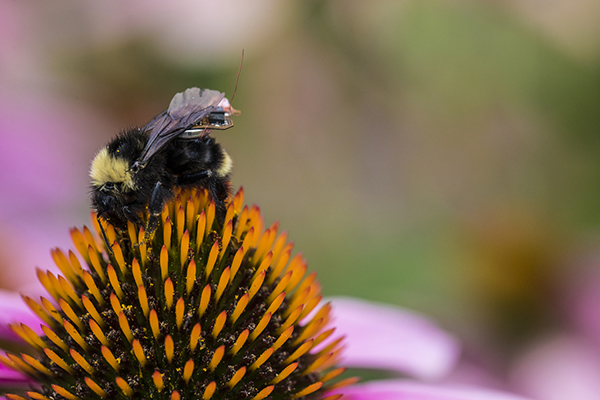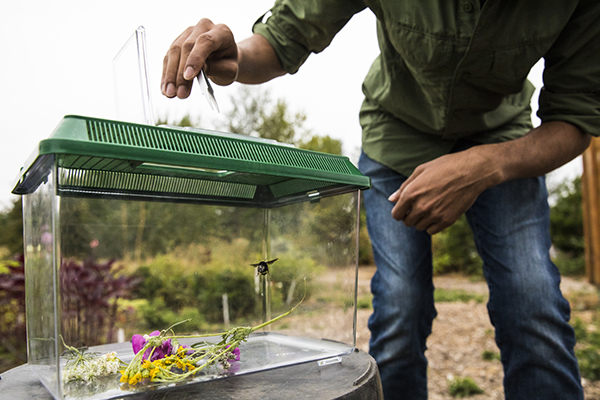A team of researchers in the Networks & Mobile Systems Lab led by Allen School professor Shyam Gollakota and the Autonomous Insect Robotics (AIR) Laboratory led by Mechanical Engineering professor Sawyer Fuller have designed a new mobile platform that combines sensing, computation, and communication in a package small enough to be carried by a bumblebee. Dubbed Living IoT, the system allows nature to take its course while enabling new capabilities in agricultural and environmental monitoring.
Living IoT’s reliance on biological, rather than mechanical, flight presents new opportunities for continuous sensing without having to repeatedly recharge power-hungry batteries throughout the day. However, it did present some novel challenges for the team, not least of which was how create a form factor small enough and light enough to ride on the back of a bee that could still power data collection and communication.
“We decided to use bumblebees because they’re large enough to carry a tiny battery that can power our system, and they return to a hive every night where we could wirelessly recharge the batteries,” explained Vikram Iyer, a Ph.D. student in Electrical & Computer Engineering and co-primary author on the research paper.
The resulting design, which incorporates an antenna, envelope detector, sensor, microcontroller, backscatter transmitter, and rechargeable battery, weighs in at a minuscule 102 milligrams — roughly half of a bumblebee’s potential payload and less than the maximum weight the team determined the insect could carry without interfering with takeoff or controlled flight.
“The rechargeable battery powering the backpack weighs about 70 milligrams,” noted Allen School Ph.D. student Rajalakshmi Nandakumar in a UW News release. “So we had a little over 30 milligrams left for everything else, like the sensors and the localization system to track the insect’s position.”
The battery offers seven hours of uninterrupted data collection time before it has to be recharged. As the bees fly around, their onboard sensors collect data such as temperature, humidity, and light intensity and store it for later upload back at the hive. That upload happens wirelessly using backscatter communication, a technique honed by members of the Networks & Mobile Systems Lab to enable a range of IoT applications.
To enable location-based sensing and data tracking in the absence of flight control, the researchers came up with a novel approach for self-localization that relies on passive operations in place of power-hungry radio receiver components. Instead, strategically positioned access point (AP) radios broadcast signals that are received by the bees as they go about their business. Using changes in the signal amplitude extracted from the onboard envelope detector, the team is able to determine the insect’s angle relative to each AP at various points throughout the day and triangulate its position to localize the sensor data. According to Allen School Ph.D. student Anran Wang, the system can detect the bee’s position within 80 meters of the antennas — roughly three-quarters of the length of a football field.
For the moment, the system is limited to roughly 30 kilobytes of data storage. If that can be expanded to include tiny cameras live streaming information about the condition of crops in the field or even the bees themselves, the notion of using live insects in place of drones for smart agriculture and other applications could really take off.
“Having insects carry these sensor systems around could be beneficial for farms because bees can sense things that electronic objects, like drones, cannot,” explained Gollakota. “With a drone, you’re just flying around randomly, while a bee is going to be drawn to specific things, like the plants it prefers to pollinate. And on top of learning about the environment, you can also learn a lot about how the bees behave.”
The team will present its research paper at MobiCom 2019, the Association for Computing Machinery’s 25th International Conference on Mobile Computing and Networking.
Read the UW News release here and visit the Living IoT project page here. Check out coverage in GeekWire, NBC Mach, CNBC, TechCrunch, Digital Trends, Vice, MIT Technology Review, New Atlas, Futurity, Engadget, Futurism, Inverse, Forbes, KOMO News, KUOW, The Seattle Times, Seattle PI, Business Insider, Digital Journal, and IEEE Spectrum.
Photo credits: Mark Stone/University of Washington



